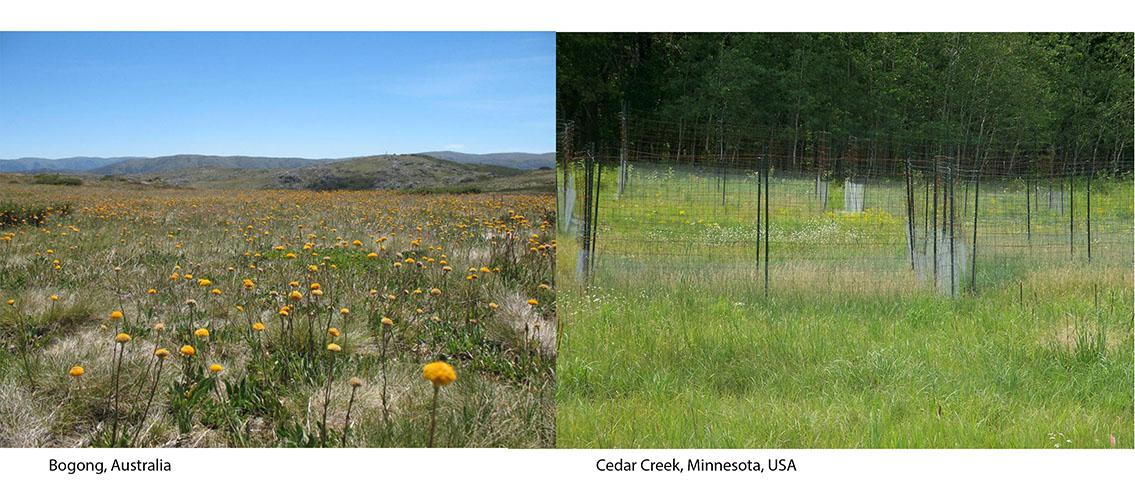
The Nutrient Network (https://nutnet.org/), aka NutNet, a global collaborative research group studying how humans affect grasslands, celebrated ten years of research in 2017. NutNet was created to study two of the largest human impacts globally, increasing supplies of elemental nutrients like nitrogen and phosphorus from agriculture and burning fossil fuels and altered food webs (e.g., changing natural predator or grazer abundances). To understand these global-scale changes, hundreds of NutNet scientists are cooperatively conducting the same experiment at over 100 grassland sites that have been established around the world. NutNet is co-directed by Professor and MSI PI Eric Seabloom and Professor Elizabeth Borer, both of the Department of Ecology, Evolution, and Behavior in the College of Biological Sciences (CBS). MSI has been a critical partner with NutNet by helping manage and maintain plant, soil, climate, and genomics data collected in the globally distributed NutNet experiment.
Professors Borer and Seabloom, along with some of their NutNet collaborators, synthesized their findings from the last 10 years in an article that appeared recently in the journal Nature Ecology and Evolution. The article focuses on three areas that the research has advanced: the complex factors influencing productivity-diversity relationships; the ecological role of soil elemental nutrients beyond just nitrogen and phosphorus, which are the most commonly studied elements; and how diversity is affected by the dual factors of increased soil nutrients and consumption by herbivores. The article can be read on the journal website: Elizabeth T. Borer, James B. Grace, W. Stanley Harpole, Andrew S. MacDougall, Eric W. Seabloom. 2017. A decade of insights into grassland ecosystem responses to global environmental change. Nature Ecology & Evolution 1:0118. doi: 10.1038/s41559-017-0018.
An article about NutNet’s anniversary was also published on the CBS website in December 2017: A Decade of Connecting.
NutNet Site Locations
Map description: The spatial and environmental range of the >100 sites participating in the NutNet project. NutNet sites (map made in R v. 3.1.1) overlain on a satellite image of Earth. Satellite image credit: NASA Goddard Space Flight Center Image by Reto Stöckli (land surface, shallow water, clouds). Enhancements by Robert Simmon (ocean colour, compositing, 3D globes, animation). Data and technical support: MODIS Land Group; MODIS Science Data Support Team; MODIS Atmosphere Group; MODIS Ocean Group Additional data: USGS EROS Data Center (topography); USGS Terrestrial Remote Sensing Flagstaff Field Center (Antarctica); Defense Meteorological Satellite Program (city lights). Figure and description from ET Borer et al. Nature Ecol. & Evolution 1:0118 (2017).
MSI provides hosting for NutNet’s MySQL database, and researchers also use analytical software available through MSI. NutNet research has previously been featured on the MSI website. Stories appeared in November 2016 (Computer Model Links Plant Species Richness and Productivity) and April 2014 (Global Experiments to Solve Ecological Problems).
The NutNet collaborative has published numerous papers, including the following highlights:
- Lind, E.M., K.J. La Pierre, E.W. Seabloom, J. Alberti, O. Iribarne, J. Firn, et al. 2017. Increased grassland arthropod production with mammalian herbivory and eutrophication: a test of mediation pathways. Ecology 98:3022-3033.
- Harpole, W.S., L.L. Sullivan, E.M. Lind, J. Firn, P.B. Adler, E.T. Borer, et al. 2016. Addition of multiple limiting resources reduces grassland diversity. Nature 537:93-96.
- Grace, J.B., T.M. Anderson, E.W. Seabloom, E.T. Borer, P.B. Adler, W.S. Harpole, et al. 2016. Integrative modelling reveals mechanisms linking productivity and plant species richness. Nature 529:390.
- Seabloom, E.W., E.T. Borer, Y.M. Buckley, E.E. Cleland, K.F. Davies, J. Firn, et al. 2015. Plant species' origin predicts dominance and response to nutrient enrichment and herbivores in global grasslands. Nature Communications 6:8.
- Fay, P.A., S.M. Prober, W.S. Harpole, J.M.H. Knops, J.D. Bakker, E.T. Borer, et al. 2015. Grassland productivity limited by multiple nutrients. Nature Plants 1:5.
- Borer, E.T., E.W. Seabloom, D.S. Gruner, W.S. Harpole, H. Hillebrand, E.M. Lind, et al. 2014. Herbivores and nutrients control grassland plant diversity via light limitation. Nature 508:517.
Image description: NutNet locations in Australia and the US. Photos from Image Gallery, NetNet.org. © Nutrient Network.
posted on March 19, 2018